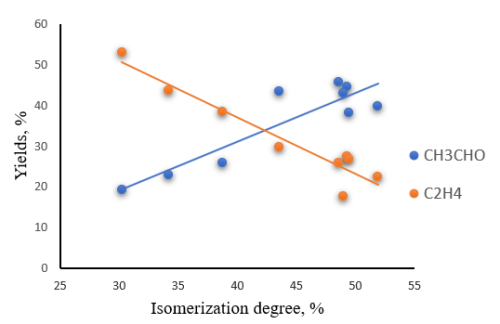
Dependence of the activity of copper-tungsten oxide catalysts in the ethanol oxidation reaction on their acidic properties
Abstract
Full Text:
PDFReferences
- S. H. Mammadova, K. H. Aghayeva, Conversion of ethanol over binary copper containing catalysts, Chemical problems, Kimya Problemleri 2, 2020, 18, 199-205.
- S.Valange, A. Beauchaud, J. Barrault, Z. Gabelica, M. Daturi, F. Can, Lanthanum oxides for the selective synthesis of phytosterol esters: Correlation between catalytic and acid-base properties, Journal of Catalysis, 2007, 251, 113-122.
- E. Sartoretti, C. Novara, A. Chiodoni, F. Giorgis, M. Piumetti, S. Bensaid, N. Russo, D. Fino, Nanostructured ceria-based catalysts doped with La and Nd: How acid-base sites and redox properties determine the oxidation mechanisms, Catalysis Today, 2022, 390–391, 117-134.
- M. Sasaki, K. Suzuki, A. Sultana, M. Haneda, H. Hamada, Effect of Acid-Base Properties on the Catalytic Activity of Pt/Al2O3 Based Catalysts for Diesel NO Oxidation, Topics in Catalysis, 2013, 56, 205–209.
- H. Pines, W. O. Haag, Alumina: Catalyst and Support. I. Alumina, its Intrinsic Acidity and Catalytic Activity, J. Am. Chem. Soc., 1960, 82, 2471-2483.
- K. Tanabe, M. Misono, H. Hattori, Y. Ono, New Solid Acids and Bases, Amsterdam, Elsevier Science, 1990, 51, 365.
- D. Martin, D. Duprez, Evaluation of the acid-base surface properties of several oxides and supported metal catalysts by means of model reactions, Journal of molecular catalysis A, 1997, 118, 113–128.
- J. C. Védrine, Acid-base characterization of heterogeneous catalysts: an up-to-date overview, Research on Chemical Intermediates, 2015, 41, 9387–9423.
- M. Guisnet, L. Pinard, Characterization of acid-base catalysts through model reactions, Catalysis Reviews, 2018, 60, 337-436.
DOI: http://dx.doi.org/10.13171/mjc02206151629baghiyev
Refbacks
- There are currently no refbacks.
Copyright (c) 2022 Mediterranean Journal of Chemistry
